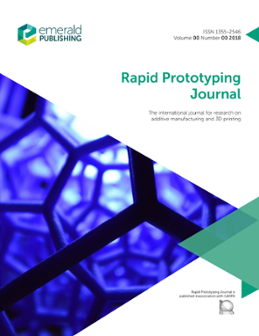Rapid Prototyping Journal: Volume 26 Issue 9
Strapline:
The international journal for research on additive manufacturing and 3D printingTable of contents
The effect of support structures on maraging steel MS1 parts fabricated by selective laser melting at different building angles
Qiqiang Cao, Jiong Zhang, Shuai Chang, Jerry Ying Hsi Fuh, Hao WangThis study aims to further the understanding of support structures and the likely impacts on maraging steel MS1 parts fabricated by selective laser melting (SLM) at 45°, 60° and…
A novel post-processing method for 316L steel specimen generated by SLM using TiN/TiAlN multilayer coating
Yueling Lyu, Yangzhi Chen, Yulin WanSelective laser melting (SLM) is an important advanced additive manufacturing technology. The existing SLM printing technology cannot manufacture the mechanical parts that fully…
Experimental verification of robust topology optimization for compliant mechanism
Xiaojun Wang, Zhenxian Luo, Xinyu GengThis paper is to present an experiment to verify that the motion errors of robust topology optimization results of compliant mechanisms are insensitive to load dispersion.
Microstructure and mechanical properties of double-wire feed GTA additive manufactured 308L stainless steel
Yang Ke, Jun XiongThis paper aims to introduce a novel concept of a double-wire feed (DWF) to alleviate heat accumulation and improve the cooling rate of the molten pool in gas tungsten arc…
Synthesis of diepoxycyclohexylethyl tetramethyldisiloxane and its application to stereolithography 3D printing
Biwu Huang, Linlin Han, Baolin Wu, Wenbin Zhou, Zhenting LuThe purpose of this study is to synthesize a new kind of a cationic-type UV-curing prepolymer diepoxycyclohexylethyl tetramethyldisiloxane, which is used to replace the current…
Evaluation of a rapid prototyping application for stomas
Jose Manuel Sierra, Jose Ignacio Rodríguez, Marta María Villazon, Jose Luis Cortizo, Maria del Rocio FernandezThis paper aims to describe the development of an internal waste-collection device for patients who have undergone a colostomy or ileostomy. Its design is based on devices that…
Experimental study of surface roughness, dimensional accuracy and time of fabrication of parts produced by fused deposition modelling
Swapnil Vyavahare, Shailendra Kumar, Deepak PanghalThis paper aims to focus on an experimental study of surface roughness, dimensional accuracy and time of fabrication of parts produced by fused deposition modelling (FDM…
Numerical modeling of thermal anisotropy on a selective laser melting process
Juan Daniel Trejos, Luis Arturo Reyes, Carlos Garza, Patricia Zambrano, Omar Lopez-BotelloAn experimental and numerical study of thermal profiles of 316 L stainless steel during selective laser melting (SLM) was developed. This study aims to present a novel approach to…
Effect of post-treatment on the microstructure and mechanical properties of selective laser melted Ti6Al4V lattice structures
Xina Huang, Lihui Lang, Shuili Gong, Mali ZhaoThe purpose of this paper is to investigate the post-treatment processes on lattice structures of selective laser melting. Moreover, the effect of pressure during hot isostatic…
Fabrication of a piezoelectrically driven micropositioning 3-DOF stage with elastic body using a multi-material 3D printer
Sang-Woo Baek, Nahm-Gyoo Cho, Dong-Hyeok LeeThis paper aims to propose a method for manufacturing multi-material monolithic structures with flexible materials to construct the elastic body by using a dual-nozzle…
Additive manufacturing of shape memory polymers: effects of print orientation and infill percentage on shape memory recovery properties
Jorge Villacres, David Nobes, Cagri AyranciThe purpose of this paper is to study the shape memory properties of SMP samples produced through a MEAM process. Fused deposition modeling or, as it will be referred to in this…
Investigations on printing path dependent properties of additively manufactured samples using micro computed tomography
Lukas Englert, Stefan Dietrich, Pascal PinterThe purpose of this paper is to understand the relationship between defect properties and the tool path used for generating additively manufactured parts. The correlation between…
An experimental methodology to analyse the structural behaviour of FDM parts with variable process parameters
Steffany N. Cerda-Avila, Hugo Iván Medellín-Castillo, Theodore LimThis paper aims to investigate the structural behaviour of polylactic acid (PLA) parts fabricated by fused deposition modelling (FDM) to support the development of analytical and…
Numerical study of heat transfer characteristics in positional wire and arc additive manufacturing
Dongqing Yang, Jun Xiong, Rong LiThis paper aims to fabricate inclined thin-walled components using positional wire and arc additive manufacturing (WAAM) and investigate the heat transfer characteristics of…
Thermal rounding of micron-sized polymer particles in a downer reactor: direct vs indirect heating
Juan Sebastian Gomez Bonilla, Maximilian Alexander Dechet, Jochen Schmidt, Wolfgang Peukert, Andreas BückThe purpose of this paper is to investigate the effect of different heating approaches during thermal rounding of polymer powders on powder bulk properties such as particle size…
Effect of infiltrant-related parameters on mechanical performance for 3DP technology
Weiwei Wu, Zhouzhou Wang, Shuang Ding, Aiping Song, Dejia ZhuThe effects of infiltrant-related factors during post-processing on mechanical performance are fully considered for three-dimensional printing (3DP) technology. The factors…
Pores and the formation mechanisms of SLMed AlSi10Mg
Tingting Wang, Shimin Dai, Hailong Liao, Haihong ZhuTo fabricate high performance parts, this paper aims to systematically study the pores characteristics and their formation mechanisms in selective laser melting (SLM) AlSi10Mg.

ISSN:
1355-2546Online date, start – end:
1995Copyright Holder:
Emerald Publishing LimitedOpen Access:
hybridEditor:
- Professor Ian Gibson